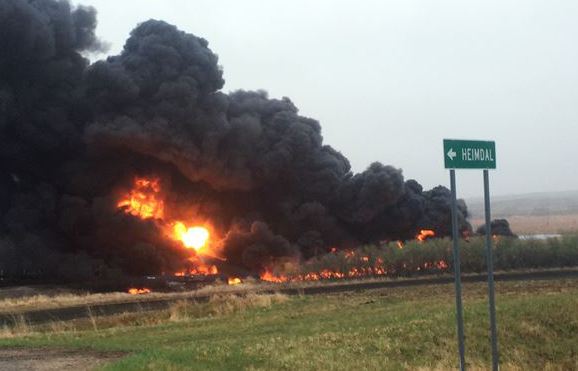BISMARCK, N.D. — A train that derailed and caught fire early Wednesday in rural North Dakota was hauling crude from the state’s oil patch, raising questions about whether new state standards intended to reduce the volatility of such shipments are sufficient.
The six tank cars that exploded into flames were a model slated to be phased out or retrofitted by 2020 under a federal rule announced last week. It’s the fifth fiery accident since February involving that type of tank car, and industry critics responded to the latest with calls for them to be taken off the tracks immediately to prevent further fires.
No injuries were reported in the derailment of the 109-car BNSF railway train at around 7:30 a.m. That prompted the evacuation of the 20-resident town of Heimdal, about 115 miles northeast of Bismarck. The Health Department was monitoring air quality and advising people not to breathe in the smoke. The danger from the smoke was mainly the particles it contains such as ash, not toxic chemicals, State Environmental Health Chief Dave Glatt said. Rain might have helped wash some of the particles out of the smoke, though it might also keep the plume closer to the ground and more likely to be encountered by people, he said.
In the immediate aftermath of the accident, BNSF vice president Mike Trevino said, the intensity of the blaze prevented firefighters from directly attacking the flames. But crews were positioning firefighting foam and other resources nearby and planned to intensify their attack.
The train was hauling Bakken oil loaded in the Tioga area, said Jeff Zent, spokesman for Gov. Jack Dalrymple. Curt Benson, a 68-year-old retired sheriff who alerted authorities, said he was getting ready for the day when the explosion outside town rattled his house. With the large number of oil trains that come through the community each day, he figured that was the cause.
“I got in my car, still in my underwear, had shaving cream on my face, and drove down there,” he said. There was no immediate word on the cause.
Members of Congress, who have called for a stricter standard to be imposed at the federal level, said Wednesday’s accident underscored that more needs to be done to prevent oil train fires that could cause a major disaster in an urban area. In 2013, a train loaded with crude derailed and exploded in the small town of Lac-Megantic, Quebec, killing 47 people.
“With trains carrying this highly-explosive material by homes, schools and businesses each day, we need a strong national volatility standard as opposed to a patchwork of state laws,” said U.S. Rep. Nita Lowey of New York, the ranking Democrat on the House Appropriations Committee.
Tessa Sandstrom with the North Dakota Petroleum Council said safety efforts should instead focus on preventing accidents through enhanced inspections of tracks and railroad equipment.
The rail line through Heimdal runs next to an intermittent waterway known as the Big Slough, which drains into the James River about 15 miles downstream near Bremen, North Dakota.
There were preliminary indications that some oil from the derailed cars got into Big Slough, but it will be difficult to verify until the fire dies down and officials can get closer to the scene, Glatt said. In a similar incident outside Casselton, North Dakota in December 2013, almost all of the spilled oil was consumed in the fire, he said.
The Federal Railroad Administration, the National Transportation Safety Board and the Environmental Protection Agency all sent investigators. The EPA planned to gauge any contamination to waterways in the vicinity, spokesman Rich Mylott said.
Since 2006, the U.S. and Canada have seen at least 24 oil train accidents involving a fire, derailment or significant amount of fuel spilled. Wednesday’s derailment comes after the Department of Transportation announced a rule Friday to toughen construction standards for tens of thousands of tank cars that haul oil and other flammable liquids.
Feinberg said the Heimdal accident was “yet another reminder” of the need for changes that have been resisted by the oil industry, which has said it could take more than a decade to get unsafe tank cars replaced or off the tracks. She said federal officials planned additional steps to improve oil train safety but offered no specifics.
The cars that derailed were constructed under a 2011 voluntary rail industry standard intended to make them tougher than older cars that were long known to pose a safety risk. But the new cars, each carrying 30,000 gallons of fuel, have proved equally dangerous.
Roughly 22,000 of the new cars that are used to haul crude oil lack an extra layer of protection to shield them against fires.
Send questions/comments to the editors.



Success. Please wait for the page to reload. If the page does not reload within 5 seconds, please refresh the page.
Enter your email and password to access comments.
Hi, to comment on stories you must . This profile is in addition to your subscription and website login.
Already have a commenting profile? .
Invalid username/password.
Please check your email to confirm and complete your registration.
Only subscribers are eligible to post comments. Please subscribe or login first for digital access. Here’s why.
Use the form below to reset your password. When you've submitted your account email, we will send an email with a reset code.